light TOYOTA PRIUS C 2015 NHP10 / 1.G Quick Reference Guide
[x] Cancel search | Manufacturer: TOYOTA, Model Year: 2015, Model line: PRIUS C, Model: TOYOTA PRIUS C 2015 NHP10 / 1.GPages: 23, PDF Size: 1.3 MB
Page 2 of 23
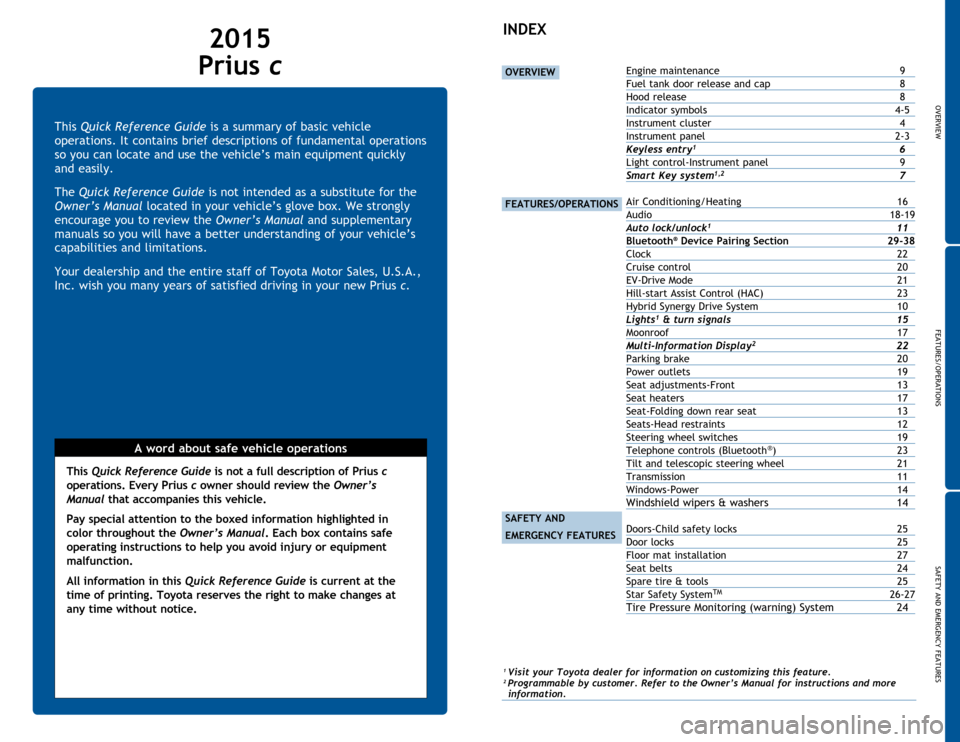
OVERVIEW
FEATURES/OPERATIONS
SAFETY AND EMERGENCY FEATURES
1
This Quick Reference Guide is a summary of basic vehicle
operations. It contains brief descriptions of fundamental operations
so you can locate and use the vehicle’s main equipment quickly
and easily.
The Quick Reference Guide is not intended as a substitute for the
Owner’s Manual located in your vehicle’s glove box. We strongly
encourage you to review the Owner’s Manual and supplementary
manuals so you will have a better understanding of your vehicle’s
capabilities and limitations.
Your dealership and the entire staff of Toyota Motor Sales, U.S.A.,
Inc. wish you many years of satisfied driving in your new Prius c.
A word about safe vehicle operations
This Quick Reference Guide is not a full description of Prius c
operations. Every Prius c owner should review the Owner’s
Manual that accompanies this vehicle.
Pay special attention to the boxed
information highlighted in
color throughout the Owner’s Manual. Each box contains safe
operating instructions to help you avoid injury or equipment
malfunction.
All information in this Quick Reference Guide is current at the
time of printing. Toyota reserves the right to make changes at
any time without notice.
2015
Prius c
INDEX
OVERVIEW
FEATURES/OPERATIONS
SAFETY AND
EMERGENCY FEATURES
Engine maintenance 9
Fuel tank door release and cap
8
Hood release
8
Indicator
symbols
4-5
Instrument
cluster
4
Instrument
panel
2-3
Keyless entry1 6
Light
control-Instrument panel
9
Smart Key system1,2 7
Air Conditioning/Heating 16
Audio 18-19
Auto lock/unlock
1 11
Bluetooth® Device Pairing Section 2 9-38
Clock
22
Cruise control
20
EV-Drive
Mode
21
Hill-start Assist Control (HAC) 23
Hybrid Synergy Drive System 10
Lights1 & turn signals 15
Moonroof
17
Multi-Information Display2 22
Parking
brake
20
Power outlets
19
Seat
adjustments-Front
13
Seat
heaters
17
Seat-Folding
down rear seat
13
Seats-Head
restraints
12
Steering
wheel switches
19
Telephone
controls (Bluetooth
®) 23
Tilt and
telescopic steering wheel
21
Transmission
11
Windows-Power
14
Windshield wipers & washers 14
Doors-Child safety locks 25
Door locks
25
Floor
mat installation
27
Seat
belts
24
Spare
tire & tools
25
Star
Safety System
TM 26-27
Tire Pressure Monitoring (warning) System 24
1 Visit your Toyota dealer for information on customizing this feature.2 Programmable by customer. Refer to the Owner’s Manual for instructions and more information.
Page 3 of 23
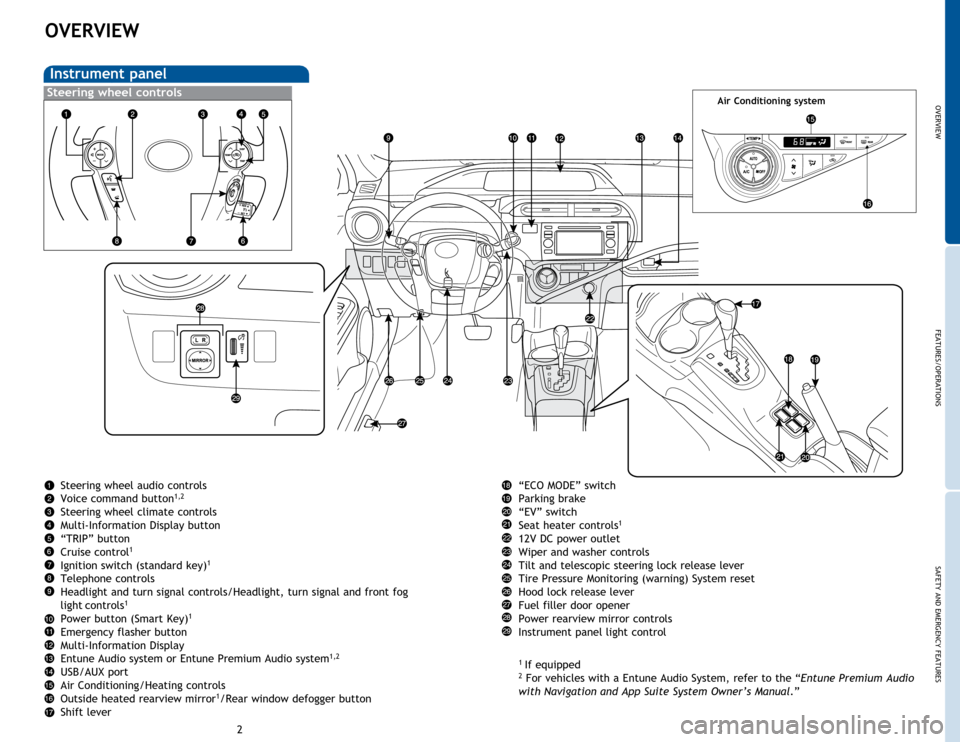
OVERVIEW
FEATURES/OPERATIONS
SAFETY AND EMERGENCY FEATURES
23
OVERVIEW
Instrument panel
Steering wheel controlsAir Conditioning system
“ECO MODE” switch
Parking brake
“EV” switch
Seat heater controls
1
12V DC power outlet
Wiper and washer controls
Tilt and telescopic steering lock release lever
Tire Pressure Monitoring (warning) System reset
Hood lock release lever
Fuel filler door opener
Power rearview mirror controls
Instrument panel light control
1
If equipped2 For vehicles with a Entune Audio System, refer to the “Entune Premium Audio
with Navigation and App Suite System Owner’s Manual .”
Steering wheel audio controls
Voice command button
1,2
Steering wheel climate controls
Multi-Information Display button
“TRIP” button
Cruise control
1
Ignition switch (standard key)1
Telephone controls
Headlight and turn signal controls/Headlight, turn signal and front fog
light
controls1
Power button (Smart Key)1
Emergency flasher button
Multi-Information Display
Entune Audio system or Entune Premium Audio system
1,2
USB/AUX port
Air Conditioning/Heating controls
Outside heated rearview mirror
1/Rear window defogger button
Shift lever
Page 4 of 23
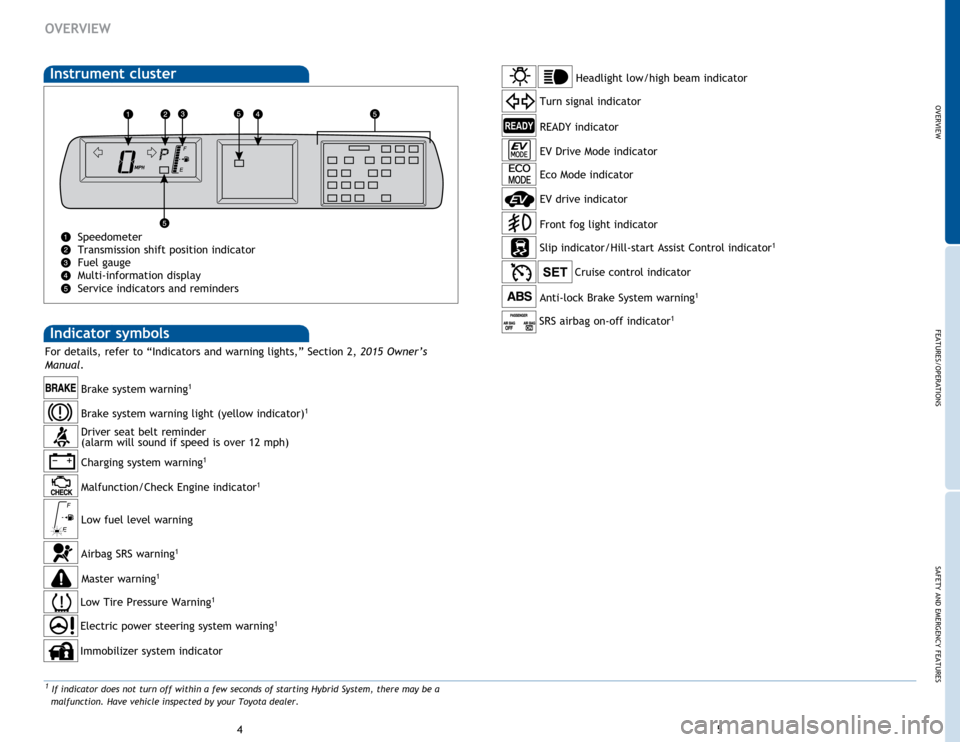
OVERVIEW
FEATURES/OPERATIONS
SAFETY AND EMERGENCY FEATURES
45
OVERVIEW
Indicator symbols
Instrument cluster
Speedometer
Transmission shift position indicator
Fuel gauge
Multi-information display
Service indicators and reminders
Charging system warning1
Brake system warning1
Anti-lock Brake System warning1
Headlight low/high beam indicator
Turn signal indicator
Slip indicator/Hill-start Assist Control indicator
1
Cruise control indicator
Low Tire Pressure Warning1
Immobilizer system indicator
Airbag SRS warning1
Master warning1
Driver seat belt reminder
(alarm will sound if speed is over 12 mph)
Malfunction/Check Engine indicator
1
Low fuel level warning
Electric power steering system warning1
READY indicator
Front fog light indicator
Brake system warning light (yellow indicator)1
Eco Mode indicator
EV Drive Mode indicator
1 If indicator does not turn off within a few seconds of starting Hybrid System, there may be a
malfunction. Have vehicle inspected by your Toyota dealer.
For details, refer to “Indicators and warning lights,” Section 2, 2015 Owner’s
Manual .
EV drive indicator
SRS airbag on-off indicator1
Page 6 of 23
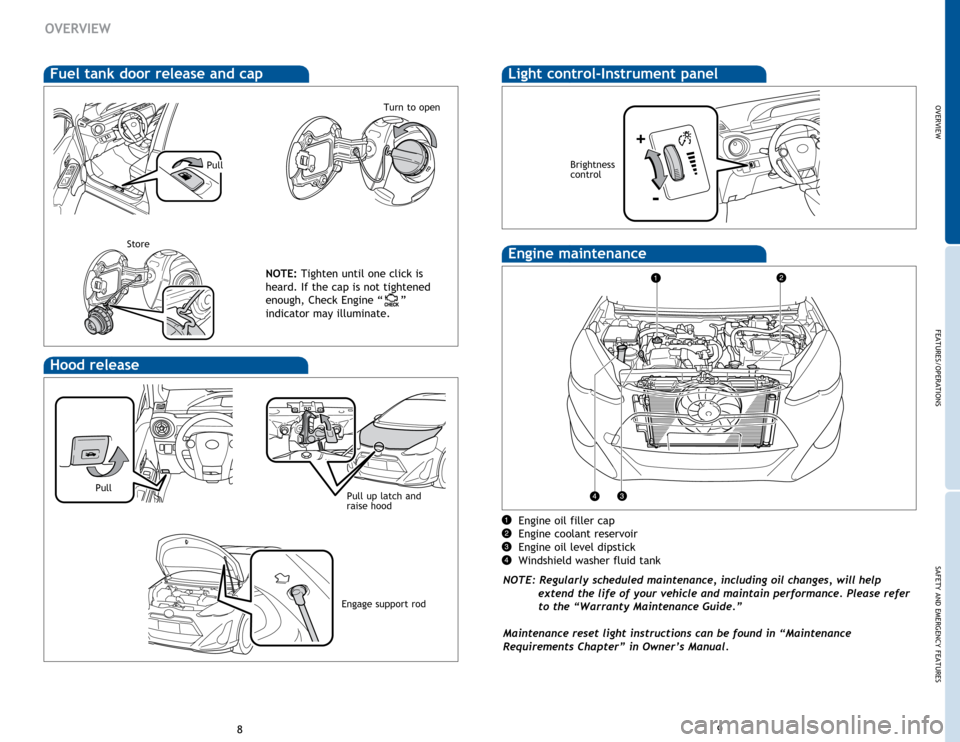
OVERVIEW
FEATURES/OPERATIONS
SAFETY AND EMERGENCY FEATURES
89
OVERVIEW
Hood release
Pull up latch and
raise hood
Fuel tank door release and cap
NOTE: Tighten until one click is
heard. If the cap is not tightened
enough, Check Engine “
”
indicator may illuminate.
Pull
Turn to open
Store
Engine oil filler cap
Engine coolant reservoir
Engine oil level dipstick
Windshield washer fluid tank
NOTE: Regularly scheduled maintenance, including oil changes, will help extend the life of your vehicle and maintain performance. Please refer
to the “Warranty Maintenance Guide.”
Maintenance reset light instructions can be found in “Maintenance
Requirements Chapter” in Owner’s Manual.
Engine maintenance
Light control-Instrument panel
Brightness
control
-
+
Engage support rod
Pull
Page 7 of 23
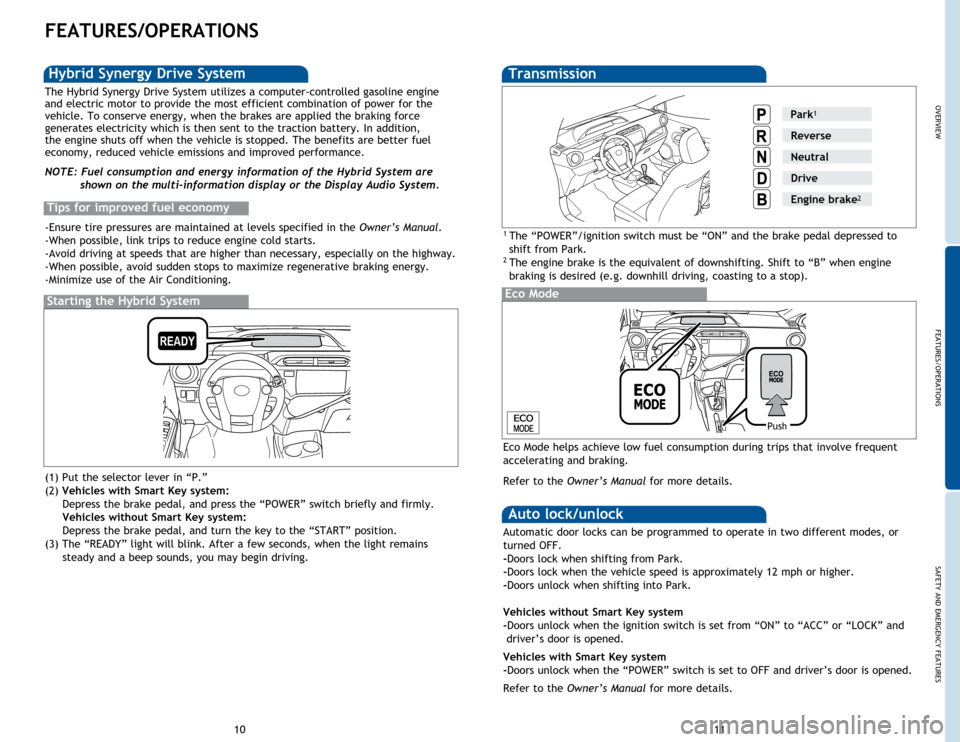
OVERVIEW
FEATURES/OPERATIONS
SAFETY AND EMERGENCY FEATURES
11
10
FEATURES/OPERATIONS
Transmission
1 The “POWER”/ignition switch must be “ON” and the brake pedal depressed to
shift from Park.
2 The engine brake is the equivalent of downshifting. Shift to “B” when engine
braking is desired (e.g. downhill driving, coasting to a stop).
Eco Mode
Push
Eco Mode helps achieve low fuel consumption during trips that involve frequent
accelerating and braking.
Refer to the Owner’s Manual for more details.
Starting the Hybrid System
The Hybrid Synergy Drive System utilizes a computer-controlled gasoline engine
and electric motor to provide the most efficient combination of power for the
vehicle. To conserve energy, when the brakes are applied the braking force
generates electricity which is then sent to the traction battery. In addition,
the engine shuts off when the vehicle is stopped. The benefits are better fuel
economy, reduced vehicle emissions and improved performance.
NOTE: Fuel consumption and energy information of the Hybrid System are
shown on the multi-information display or the Display Audio System.
Tips for improved fuel economy
-Ensure tire pressures are maintained at levels specified in the Owner’s Manual.
-When possible, link trips to reduce engine cold starts.
-Avoid driving at speeds that are higher than necessary, especially on the highway.
-When possible, avoid sudden stops to maximize regenerative braking energy.
-Minimize use of the Air Conditioning.
Hybrid Synergy Drive System
Auto lock/unlock
Automatic door locks can be programmed to operate in two different modes, or
turned OFF.
-Doors lock when shifting from Park.
-Doors lock when the vehicle speed is approximately 12 mph or higher.
-Doors unlock when shifting into Park.
Vehicles without Smart Key system
-Doors unlock when the ignition switch is set from “ON” to “ACC” or “LOCK” and
driver’s door is opened.
Vehicles with Smart Key system
-Doors unlock when the “POWER” switch is set to OFF and driver’s door is opened.
Refer to the Owner’s Manual for more details.
(1) Put the selector lever in “P.”
(2)
Vehicles with Smart Key system:
Depress
the brake pedal, and press the “POWER” switch briefly and firmly.
Veh
icles without Smart Key system: Depress
the brake pedal, and turn the key to the “START” position.
(3) The “READY” light will blink. After a few seconds, when the light remains
steady
and a beep sounds, you may begin driving.
Park1
Reverse
Neutral
Drive
Engine brake2
Page 9 of 23
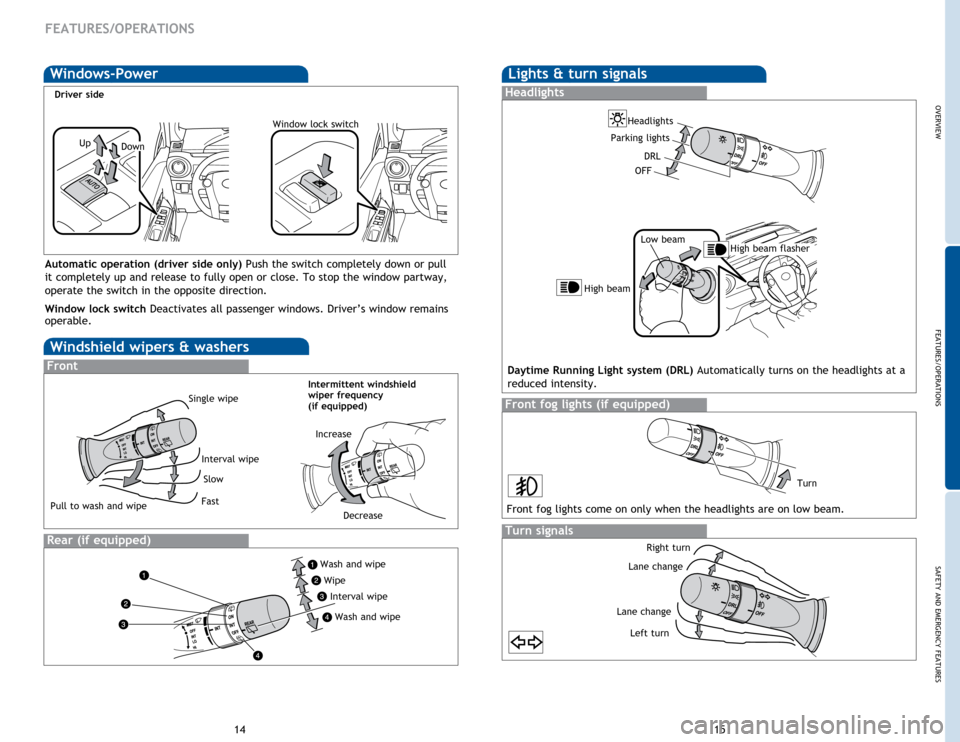
OVERVIEW
FEATURES/OPERATIONS
SAFETY AND EMERGENCY FEATURES
1415
FEATURES/OPERATIONS
Windshield wipers & washers
Interval wipe
Single wipe
Slow
Fast
Pull to wash and wipe
Front
Rear (if equipped)
Wash and wipe
Wipe Interval wipe
Wash and wipe
Lights & turn signals
Turn signals
Headlights
High beam flasher
Low beam
Front fog lights (if equipped)
Daytime Running Light system (DRL) Automatically turns on the headlights at a
reduced intensity.
Front fog lights come on only when the headlights are on low beam.
Right turn
Lane change
Lane change Left turn
High beam
Parking lights
Turn
Headlights
Windows-Power
UpDown
Window lock switch
Automatic operation (driver side only) Push the switch completely down or pull
it completely up and release to fully open or close. To stop the window partway,
operate the switch in the opposite direction.
Window lock switch
Deactivates all passenger windows. Driver’s window remains
operable.
OFF
Intermittent windshield
wiper frequency
(if equipped)
Increase
Decrease
Driver side
DRL
Page 12 of 23
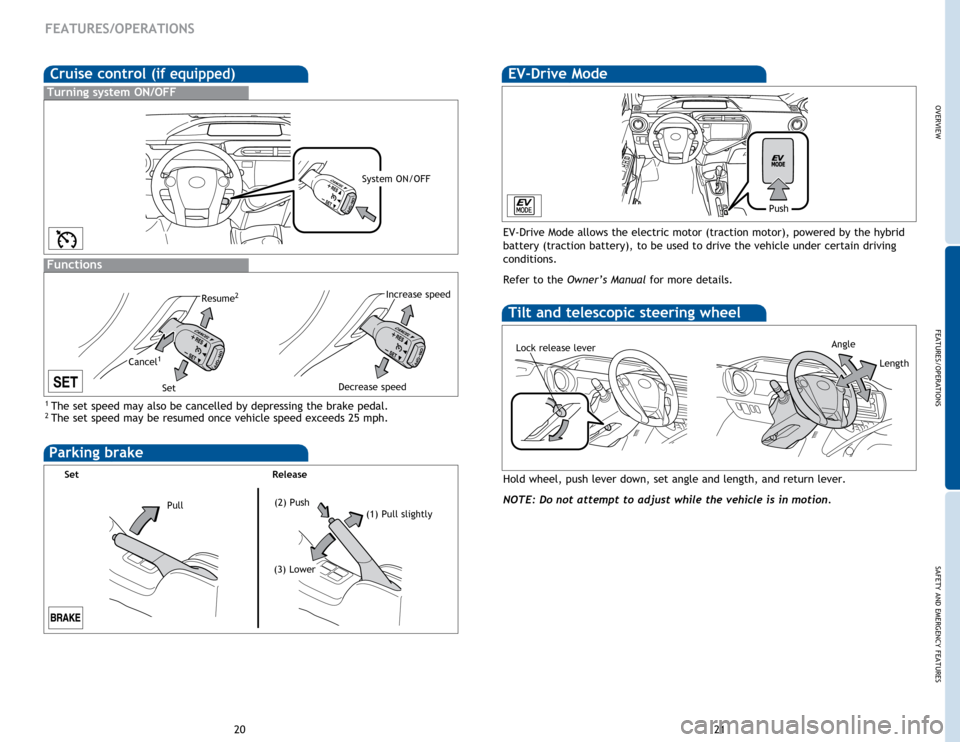
OVERVIEW
FEATURES/OPERATIONS
SAFETY AND EMERGENCY FEATURES
21
20
Cruise control (if equipped)
1 The set speed may also be cancelled by depressing the brake pedal.2 The set speed may be resumed once vehicle speed exceeds 25 mph.
Turning system ON/OFF
Functions
System ON/OFF
Increase speed
Decrease speed
Cancel1
Resume2
Set
FEATURES/OPERATIONS
Hold wheel, push lever down, set angle and length, and return lever.
NOTE: Do not attempt to adjust while the vehicle is in motion.
Tilt and telescopic steering wheel
EV-Drive Mode
EV-Drive Mode allows the electric motor (traction motor), powered by the hybrid
battery (traction battery), to be used to drive the vehicle under certain driving
conditions.
Refer to the Owner’s Manual for more details.
Push
Angle
Length
Lock release lever
Parking brake
Set Release
Pull(2) Push(1) Pull slightly
(3) Lower
Page 14 of 23
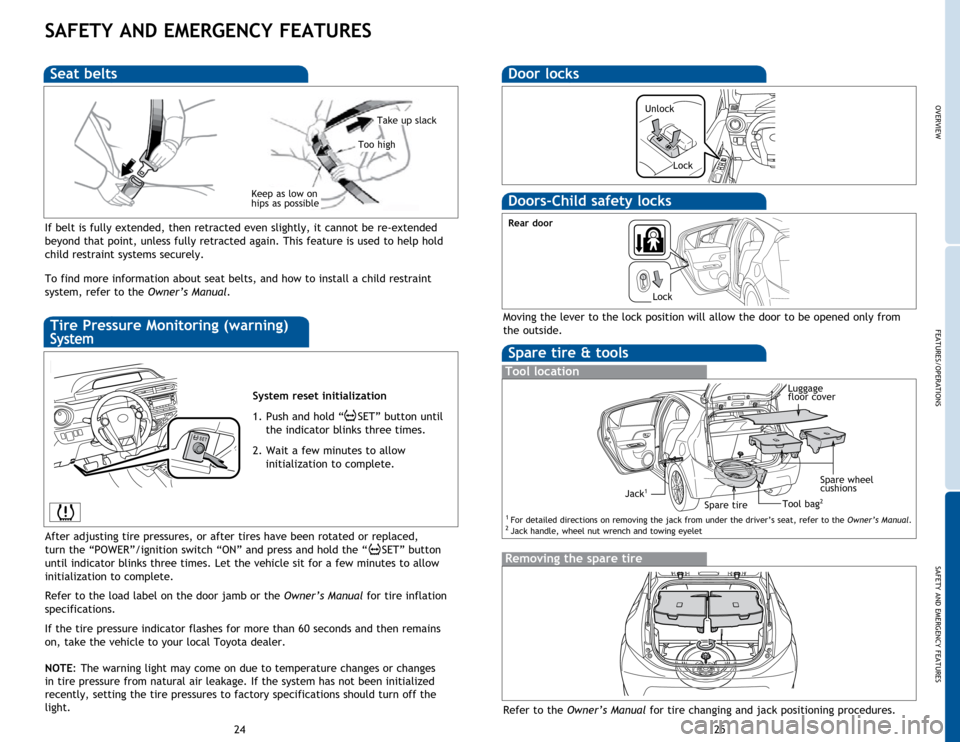
OVERVIEW
FEATURES/OPERATIONS
SAFETY AND EMERGENCY FEATURES
25
24
SAFETY AND EMERGENCY FEATURES
If belt is fully extended, then retracted even slightly, it cannot be re-extended
beyond that point, unless fully retracted again. This feature is used to help hold
child restraint systems securely.
To find more information about seat belts, and how to install a child restraint
system, refer to the Owner’s Manual.
Keep as low on
hips as possible
Take up slack
Too high
Seat beltsDoor locks
Tire Pressure Monitoring (warning)
System
Spare tire & tools
Tool location
Removing the spare tire
Refer to the Owner’s Manual for tire changing and jack positioning procedures.
Spare tireTool bag2
Moving the lever to the lock position will allow the door to be opened only from
the outside.
Rear door
Jack1Spare wheel
cushions
Doors-Child safety locks
Lock
Unlock
STEP4
System reset initialization
1. Push and hold “
SET” button until
the indicator blinks three times.
2. Wait a few minutes to allow initialization to complete.
After adjusting tire pressures, or after tires have been rotated or replaced,
turn the “POWER”/ignition switch “ON” and press and hold the “
SET” button
until indicator blinks three times. Let the vehicle sit for a few minutes to allow
initialization to complete.
Refer to the load label on the door jamb or the Owner’s Manual for tire inflation
specifications.
If the
tire pressure indicator flashes for more than 60 seconds and then remains
on, take the vehicle to your local Toyota dealer.
NOTE:
The
warning light may come on due to temperature changes or changes
in tire pressure from natural air leakage. If the system has not been initialized
recently, setting the tire pressures to factory specifications should turn off the
light.
Luggage
floor cover
1 For detailed directions on removing the jack from under the driver’s seat, refer to the Owner’s Manual.2 Jack handle, wheel nut wrench and towing eyelet
Lock
Page 17 of 23
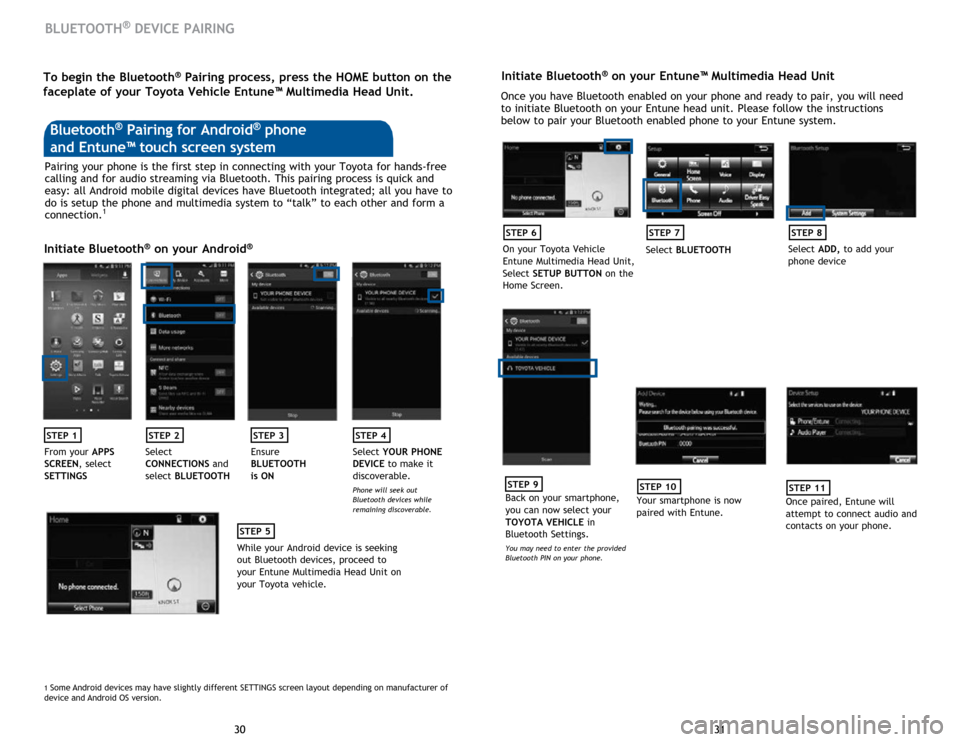
31
30 31
30
BLUETOOTH® DEVICE PAIRING
Initiate Bluetooth® on your Entune™ Multimedia Head Unit
Once you have Bluetooth enabled on your phone and ready to pair, you will need
to initiate Bluetooth on your Entune head unit. Please follow the instructions
below to pair your Bluetooth enabled phone to your Entune system.
STEP 6
On your Toyota Vehicle
Entune Multimedia Head Unit,
Select SETUP BUTTON on the
Home Screen.
STEP 7
Select BLUETOOTH
STEP 8
Select ADD, to add your
phone device
STEP 9
Back on your smartphone,
you can now select your
TOYOTA VEHICLE in
Bluetooth Settings.
You may need to enter the provided
Bluetooth PIN on your phone.
STEP 10
Your smartphone is now
paired with Entune.
STEP 11
Once paired, Entune will
attempt to connect audio and
contacts on your phone.
Pairing your phone is the first step in connecting with your Toyota for hands-free
calling and for audio streaming via Bluetooth. This pairing process is quick and
easy: all Android mobile digital devices have Bluetooth integrated; all you have to
do is setup the phone and multimedia system to “talk” to each other and form a
connection.
1
Initiate Bluetooth® on your Android®
STEP 1STEP 2STEP 3STEP 4
From your APPS
SCREEN, select
SETTINGS Select
CONNECTIONS
and
select BLUETOOTH Ensure
BLUETOOTH
is ON Select
YOUR PHONE
DEVICE to make it
discoverable.
Phone will seek out
Bluetooth devices while
remaining discoverable.
STEP 5
While your Android device is seeking
out Bluetooth devices, proceed to
your Entune Multimedia Head Unit on
your Toyota vehicle.
Bluetooth® Pairing for Android® phone
and Entune™ touch screen system
1 Some Android devices may have slightly different SETTINGS screen layout depen\
ding on manufacturer of
device and Android OS version.
To begin the Bluetooth® Pairing process, press the HOME button on the
faceplate of your Toyota Vehicle Entune™ Multimedia Head Unit.